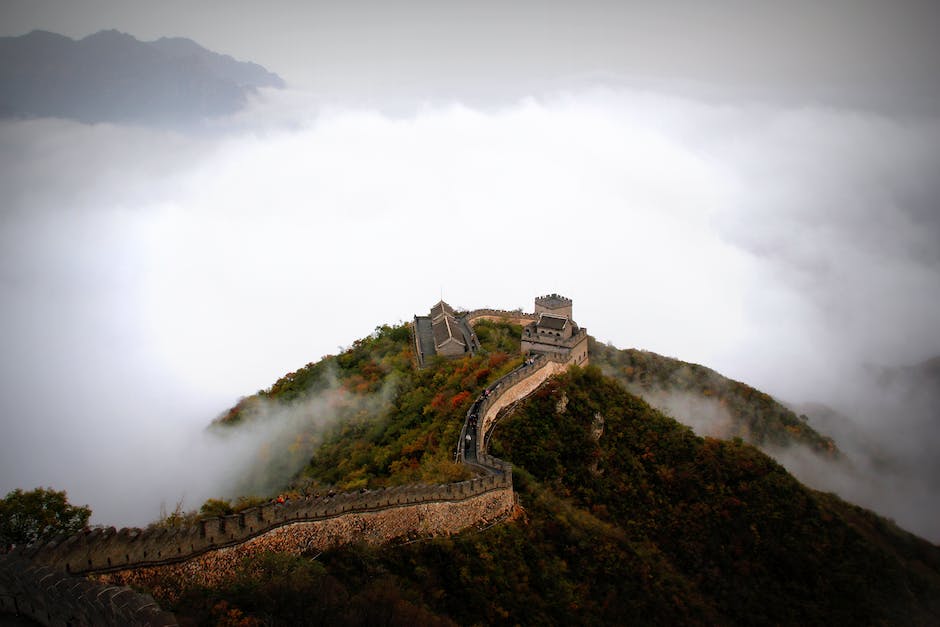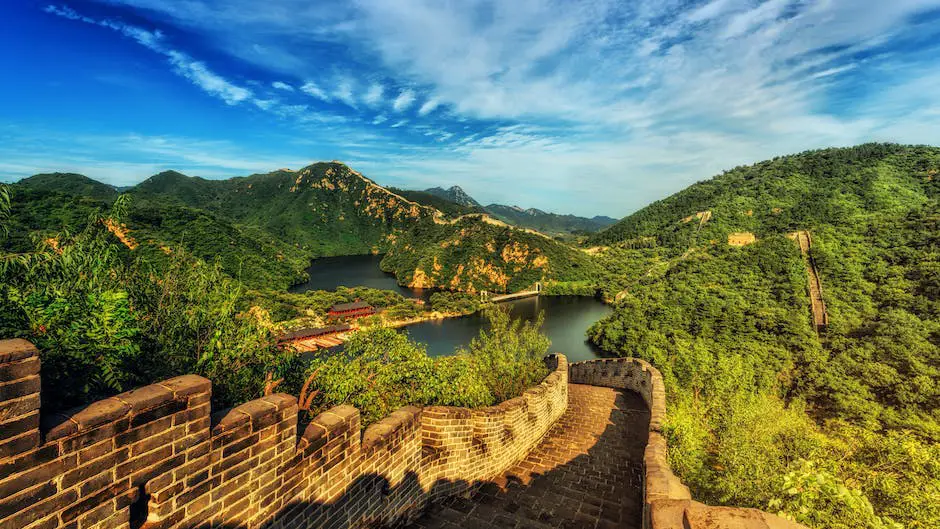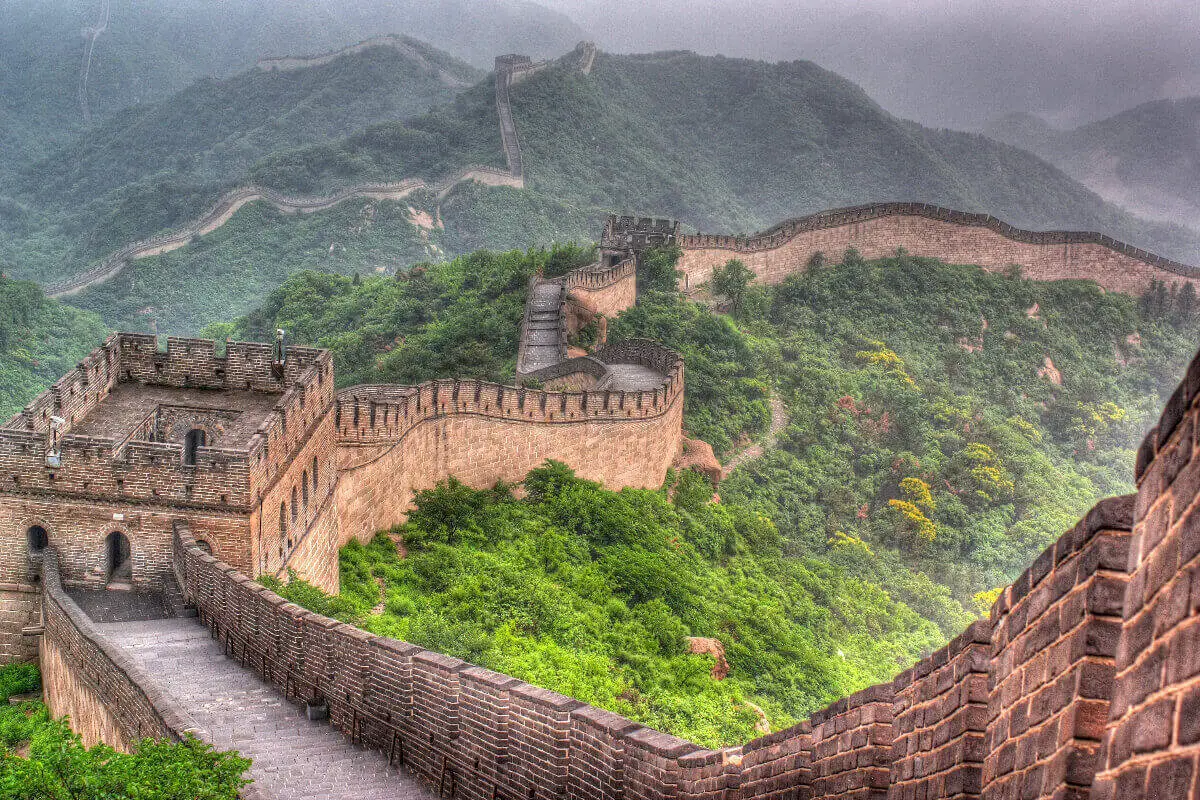The Great Wall of China, an architectural wonder that stretches over 13,000 miles, forms a spectacular thread woven into the tapestry of Chinese history. Its chronicles are etched into every block and stone, telling tales of awe-inspiring human endeavor from the early genesis as non-continuous fortifications in the 7th century B.C. through centuries of expansion and transformation till its state in the contemporary world.
The Great Wall is not just a parapet against foreign invasion but a symbol of China’s resilience and innovation, with every segment echoing the narrative of the era under which it was constructed.
Table of Contents
- The Genesis of the Great Wall
- The Transformation of the Great Wall over centuries
- The Great Wall in Modern Times
- Related Questions
The Genesis of the Great Wall
Ladies, gentlemen, and esteemed wanderlusters of the world, it’s time to don our time-traveling outfits, for we are about to explore another gem from our world’s treasure cove: The Great Wall of China – an architectural beauty shaped by the sands of time.
Blending ancient history with a dash of intriguing mystery, The Great Wall of China stands resplendent in the chronicles of humanity. Initially, a series of smaller walls eventually succumbed to an architectural evolution to form the colossal structure we admire today.
So, how old is this vast, winding dragon of earth and rock snaking over the Chinese countryside? Let’s dive headfirst into this question!
History whispers to us that the construction of The Great Wall of China sprang up around the 7th century B.C. You read it right – it’s older than most written history! Tiny bits of various walls were being built by individual states during the Spring and Autumn (770 – 476 B.C.) and Warring States periods (475 – 221 B.C.) of ancient China.
It’s believed that construction began during the reign of Duke Xiang of Qi or Duke Zhuang of Chu countless moons ago. Much like the Netflix show you can’t stop binging on, the goal was to keep out the trailers – in this case, potentially hostile nomadic tribes.
However, today, the Great Wall that enchants our imaginations traces back to the Ming dynasty (1368 – 1644 A.D.). During their reign, they kick-started a construction boom, fortifying some 5,500 miles of Wall.
The Great Wall grew from a regional network to an empire-wide defense system thanks to the Ming.
The Ming dynasty, armed with the secrets of gunpowder and bricks, brought forth a sturdier and more secure Great Wall. They say, as travelers, we leave behind a part of our hearts in the places we explore. The Ming Dynasty left behind a timeless narrative of their battles and courage, etched in the bricks of this magnificent Wall.
So, there you have it, dear fellow nomads! Today’s wanderlust-fueled knowledge nugget served on a platter. And remember, it’s not just about visiting places; it’s about unveiling stories.
Behind every monument, every path, there’s always a story waiting to be discovered – just like the majestic Great Wall of China, standing steadfast through the ebbs and flows of time for over two millennia. Happy exploring!

The Transformation of the Great Wall over centuries
Through seasons and centuries, the Great Wall continues to stand tall as a testament to the ingenuity and tenacity of humanity. This magnificent infrastructural marvel has continually evolved, physically and symbolically, shifting in design, materials, and purpose, mirroring the rise and fall of dynasties and the zeitgeist of the times.
The progression from simple rammed earth walls in the early periods to stone, wood, and even tamped earth during the Han dynasty (206 BC-AD 220) is indicative not only of the advancements in construction methodology of the time but also of the changing conditions and requirements.
The harsh terrain and extreme weather conditions in the northern frontier, where the majority of Han’s Wall was constructed, necessitated the use of local resources such as desert poplar, reeds, and red willow – materials that were both abundant and well-suited to the dry, arid environment.
Fast forward to the era of the Jin dynasty (1115 – 1234), we see the Wall undergoing another significant transformation. The Jin, which in part emerged victorious against the Song dynasty with the help of innovative military technologies, were strategic in incorporating certain defensive features into the Wall.
Semi-circular guard towers, signal stations for effective communication, and the introduction of smoke signals for sending long-distance messages saw the Wall evolve from a simple barrier to an intricate defensive fortification system.
The transitions during the Ming dynasty are already well-known. Still, it’s worth noting the innovative use of materials like bricks, stones, and designs, including crenels, for better defensibility.
The watchtowers were upgraded into beacon towers, serving dual purposes – a higher vantage point for surveillance and a platform for sending warning signals.
As we move into modern times, the Wall has taken on an entirely new role – a symbol of unity and national pride. The restoration activity during the 20th century underscored China’s commitment to preserve and protect this invaluable historical monument, a sentiment echoed around the globe.
Structural fortifications were meticulously repaired, ensuring the Wall’s characteristic features and integrity were not compromised. The respect for retaining authenticity is reflected in using traditional materials and methods during repairs and maintenance.
As this grand sentinel celebrates more than two millennia of existence, its evolution in architecture and function serves as a fascinating chronicle of China’s history. Peel back the layers of time, and the Great Wall tells a tale of changing dynasties, the ebb and flow of cultural influences, and an endless quest for innovation.
It’s a lesson in humanity’s adaptability, for who else could conceive of such a fortification in the face of adversity, only to witness its transformation into a unifying symbol for the world?
Visiting the Wall resembles a fascinating journey through time, where every twist, turn, and rampart whispers tales from bygone eras. It’s more than a testament to battles and courage, more than bricks and mortar – the Great Wall is a grand ode to the human spirit.

The Great Wall in Modern Times
While it’s impossible to stand atop the Great Wall of China and not marvel at the ingenuity of its creators, the expansive monument is more than just a testament to engineering prowess.
It serves as a living timeline of China’s dynamic history, from the Spring and Autumn period to the modern era, each brick carrying stories etched in time. Age, nature, and human influence have presented challenges to its preservation, yet the Wall stands resilient, symbolizing humanity’s unconquerable spirit.
For over 2000 years, the Great Wall has evolved in structure and design, its transformations reflective of the pulses of change sweeping through China.
Initially a series of rammed-earth fortifications, it transformed under the wise guidance of the Jin Dynasty when a hybrid of earth and bricks began to fortify the Wall. The Ming Dynasty was perhaps the greatest architect of change, leaving a lasting mark on the Wall’s narrative.
Working with the bountiful local resources of their times, each set of builders infused the Great Wall with a natural resilience that harnesses the best of locally available. From tamped earth to stone and kiln-fired bricks, the ingenuity of their construction methods is still evident.
While the Great Wall was, at its heart, a military installation, its strategic defensive features are a testament to the strength and resolve that fueled its creation.
Towers for surveillance, beacon towers for communication, and passes for transport — all these features stand entrenched within its length, presenting a fascinating narrative of defense and resilience.
Slowly, over time, the Great Wall seeped into China’s cultural and emotional soil, its bricks becoming synonymous with unity and national pride. Even Pu Yi, the last emperor of China, refers to the Great Wall as the “best emperor,” highlighting the structure’s symbolic importance.
Today, the Wall is not just a fort but a chronicle of China’s cultural evolution and the threads weaving its complex historical tapestry together.
And yet, the test of time has taken its toll on the Great Wall. To preserve this architectural treasure for future generations, organizations and even local communities have put considerable effort into place.
Conservation initiatives focus on maintaining the authenticity of the monument, with conservative restoration techniques designed to retain as much of the original materials and designs as possible. In some cases, preventive structures are erected to shield vulnerable parts from natural elements like wind and rain.
In its enduring presence, the Great Wall is not only a marvel of human capability for present generations but also a journey through time that has withstood the infringements of nature and human impacts alike.
Each brick remains a silent storyteller, whispering tales of perseverance, unity, and bravura that weave the fabric of China’s historical chronicle.
As wanderlust pulls us to the wind-swept parapets of the Great Wall, we become a part of its eternal narrative. Walking along its vast spine, you stand within a testimony to humankind’sty adaptability and enduring spirit, tracing the echoes of a civilization that once was and continues to be, all packaged in an incredible fortification that stretches as far as the eyes can see.

Despite the ravages of time and threats from artificial and natural elements, the Stoic Great Wall remains resilient, standing tall as a testament to China’s rich culture and history.
The climactic chapters of the Great Wall may reveal a landscape weathered, irrevocably damaged, and slowly receding into memory, but its legacy is immortal. The preservation endeavors of today serve as attempts to sustain this magnificent edifice and carry forward the narratives it embodies, keeping the whispers of the past alive in the march toward the future.
Scrutinizing the history of the Great Wall promotes an enthralling exploration into China’s past epochs, offering insights from strategies employed against invasions to trends in ancient construction techniques and the determined spirit of human endurance.
At A Bus On A Dusty Road, we talk about travel, life, and ex-pat living. We are all about “Living Life As A Global Citizen.” We explore social, cultural, and economic issues and travel.
We would love to have you be part of our community. Sign up for our newsletter to keep up-to-date by clicking here. If you have any questions, you can contact me, Anita, by clicking here.
Listen to our Podcast called Dusty Roads. You can find it on all major podcast platforms. Try out listening to one of our podcasts by clicking here.
Subscribe to our A Bus On A Dusty Road YouTube Channel with great videos and information by clicking here.
Related Questions
What Are The Differences Between Shanghai And Beijing, China?
Shanghai and Beijing are two important cities in China. Beijing is the capital of China; all of China is ruled from Beijing. Shanghai is also an important city in China as it is a financial and business hub. It is also the most populated city in China. Though they are both cities located in China they do have some unique differences.
By clicking here, you can discover What Are The Differences Between Shanghai And Beijing, China?
When Was China’s War With Vietnam?
The most significant conflict between China and Vietnam happened in 1979 – the Sino-Vietnamese War – although tensions had been building for some time due to disputes over territorial waters and Vietnam’s involvement in Southeast Asia, this war had a lasting impact on both Vietnam and China.
By clicking here, you can discover When Was China’s War With Vietnam?
Guide To The Boxer Rebellion & China’s Independence
The Boxer Rebellion was an uprising in China during the late 19th Century. A secret Chinese society known as the boxers was formed; their main goal was to drive all foreign influences from Chinese soil. The fighters were motivated by a belief that foreigners had overstepped their bounds within China and were depriving many of the Chinese people of their culture and rights.
By clicking here, you can discover Guide To The Boxer Rebellion & China’s Independence.


